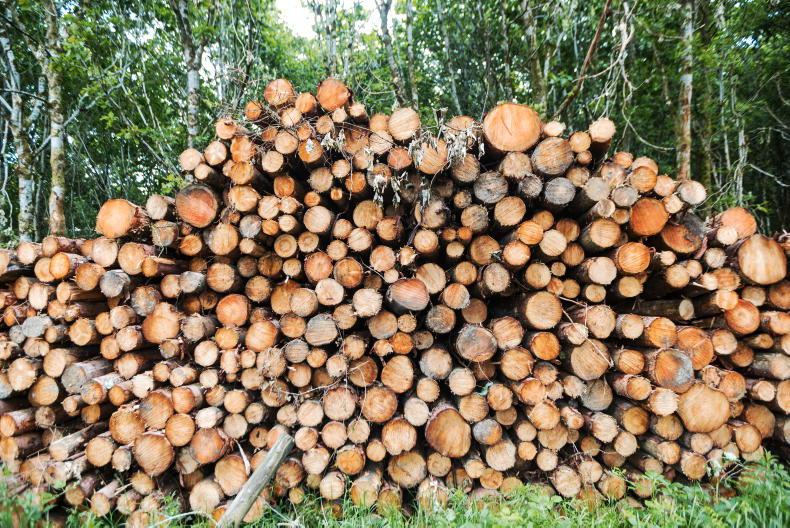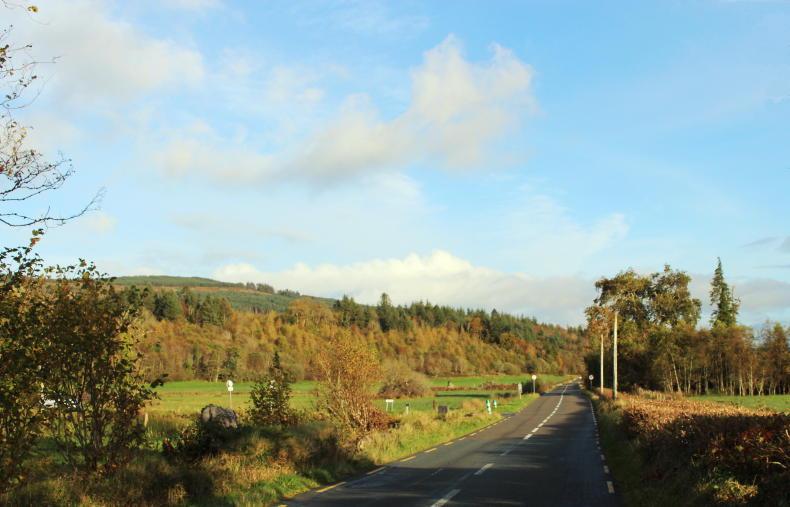Sustainable forest management (SFM) is the stewardship of forests to meet present economic, environmental and social needs, without compromising the needs of future generations.
Achieving a balance between the three pillars of sustainability – economic, environmental and social – is fundamental to SFM, but it is also the most contentious.
The way to measure these pillars, as objectively as possible, is through forest certification, which is provided to growers who can prove to an independent certification body that their forests are managed according to the principles of SFM.
The two international certification bodies operating in Ireland are the Forest Stewardship Council (FSC) and the Programme for the Endorsement of Forest Certification (PEFC).
SFM begins with the forest owner, but doesn’t end at the forest gate. In addition to forest owners, sawmills and wood-based panel mills that source timber from certified forests can receive chain of custody certification, as well as companies further removed from the forest, such as paper print suppliers and publishers.
These companies can brand their products with either the ‘FSC’ or ‘PEFC’ logos, which is proof to environmentally conscious customers that the product has been sourced from forests practising SMF.
It serves the same purpose as Fairtrade branding of food products such as bananas, coffee and tea that we see on supermarket shelves.
Certification
Certification is a relatively new concept in forestry. It was introduced by non-governmental bodies in the 1990s as a means of tackling illegal logging, deliberate burning and forest degradation, especially in tropical forests.
Developed countries led by example and adopted certification, conscious that overexploitation also existed in Europe and North America up until the 19th century and early 20th century in Ireland.
In Ireland, SFM is sufficiently versatile to allow a range of forest types to evolve, including native and introduced species, with space for commercial and conservation management to coexist. This mirrors David Attenborough’s approach to global forestry, which is to protect and enhance “those last remaining ancient forests” with the need “to farm trees” to build houses and displace fossil-based materials.
Attenborough’s call to conserve our ancient forests is tempered with the realisation that “the natural forests can’t provide all the wood that we need”.
In Ireland, SFM is sufficiently versatile to allow a range of forest types to evolve, including native and introduced species
This forest duality – conservation and production – is also central to forest policy in Ireland, where the challenge lies in expanding the productive forest resource in tandem with the protection and enhancement of our native woodland resource.
Positives of multipurpose forestry
By getting this balance right, multipurpose forestry has a positive influence on sustained yield of forest produce, climate change, biodiversity, water quality and landscape enhancement.
Its greatest influence is on people’s wellbeing, especially as a place of recreation, but also as a place of work and revenue generation for rural communities.
For these communities, the economic objective of forestry is essential to protect and enhance their livelihoods. It is important that these important social and economic pillars of SFM are acknowledged fully in the certification process.
Some of the requirements in the FSC process suggest that they are not. More worryingly, a number of requirements outlined in “The FSC Interim National Standard” contravene the national forestry guidelines and conditions, such as excluding reforestation on peat sites after clearfelling, which would rule out a living for forest owners on such sites.
Carbon accounting
Some proposed conditions by FSC preclude small-scale forest owners entering the certification process.
For example, FSC now requires that “[a] system is implemented to collect the data necessary to compile a full life-cycle carbon accounting for management activities”. This includes every operation along the forest and forest products chain, including the reforestation of harvested crops.
Some proposed conditions by FSC preclude small-scale forest owners entering the certification process
This has been opposed even by forest owners and sawmills who have FSC certification.
Apart from being enormously expensive, this condition would be impossible to implement in Ireland, as we don’t have a forest carbon code or any similar carbon accounting mechanism in place.
Both FSC and PEFC has strenuous ecological conditions, but PEFC, judging from its international conference hosted last year in Ireland, places strong emphasis on people and the role of wood in displacing concrete and steel in construction.
This is essential if Ireland is to achieve net zero by mid-century, as outlined by Ireland’s Climate Action Plan.
In addition, PEFC has an Irish office and national secretary, William Merivale, while FSC has no office or discernible presence in Ireland – not a good image when certification places strong emphasis on the role of communities in SFM.
There is now a need for a long-term, co-ordinated plan for forest certification “that is backed by sectoral and Government support and national policy”, according to Mechteld Schuller of the Irish Timber Growers Association.
“In order to achieve economies of scale in forest certification, the wider sector must take the initiative and start working together by embracing certification as a common goal and setting up systems and structures to achieve these aims,” she says.
The Department of Agriculture, Food and the Marine is playing an important role in supporting forest owner groups in achieving certification, but it needs to take a further step.
To achieve economies of scale in forest certification, the wider sector must take the initiative and start working together by embracing certification as a common goal
It is clear that the Department, together with growers, timber processors and all relevant stakeholders, takes a more proactive role, especially in developing a national certification standard.
Plantation-productive forestry
Plantation forestry is synonymous with production forestry. In 2000, plantations were only about 5% of the global forest cover (0.33% of the land area), but produced 35% of global roundwood production, according to the FAO.
By 2015, plantations reached 291m ha, with an average annual increment of 1.84% since 1990.
It is now accepted that plantation forests have a major role to play in sustainable forest management and future wood production to displace fossil-based materials.
On the downside, plantation forestry is also synonymous with monocultures in some countries. In Ireland, especially from the 1950s to the turn of the century, afforestation relied on two main coniferous species – but close examination of forest structures demonstrates that Irish forests are not monocultures based on recent and current trends.
Since 2000, broadleaves – mainly native – have gradually increased to 40% of total tree species selection. All new forests under the new forestry programme must carry 35% broadleaves and open biodiverse area.
As the average size of new afforestation sites is 7ha, this means that, at most, these plantations will carry a maximum 4.5ha conifer crop – hardly a monoculture by any definition or, the IFA and other bodies would contend, not even a commercial forest.
The recent Department decision to opt for a 50% native species – given the paucity of native tree species and realistically matching these to Irish soil and site conditions – is debatable at the very least.
It further downgrades the economic and social objectives of SFM, but at least gives the lie to the perception that forest policy in Ireland is commercially focused.
Nothing could be further from the truth.
Sustainable forest management (SFM) is the stewardship of forests to meet present economic, environmental and social needs, without compromising the needs of future generations.
Achieving a balance between the three pillars of sustainability – economic, environmental and social – is fundamental to SFM, but it is also the most contentious.
The way to measure these pillars, as objectively as possible, is through forest certification, which is provided to growers who can prove to an independent certification body that their forests are managed according to the principles of SFM.
The two international certification bodies operating in Ireland are the Forest Stewardship Council (FSC) and the Programme for the Endorsement of Forest Certification (PEFC).
SFM begins with the forest owner, but doesn’t end at the forest gate. In addition to forest owners, sawmills and wood-based panel mills that source timber from certified forests can receive chain of custody certification, as well as companies further removed from the forest, such as paper print suppliers and publishers.
These companies can brand their products with either the ‘FSC’ or ‘PEFC’ logos, which is proof to environmentally conscious customers that the product has been sourced from forests practising SMF.
It serves the same purpose as Fairtrade branding of food products such as bananas, coffee and tea that we see on supermarket shelves.
Certification
Certification is a relatively new concept in forestry. It was introduced by non-governmental bodies in the 1990s as a means of tackling illegal logging, deliberate burning and forest degradation, especially in tropical forests.
Developed countries led by example and adopted certification, conscious that overexploitation also existed in Europe and North America up until the 19th century and early 20th century in Ireland.
In Ireland, SFM is sufficiently versatile to allow a range of forest types to evolve, including native and introduced species, with space for commercial and conservation management to coexist. This mirrors David Attenborough’s approach to global forestry, which is to protect and enhance “those last remaining ancient forests” with the need “to farm trees” to build houses and displace fossil-based materials.
Attenborough’s call to conserve our ancient forests is tempered with the realisation that “the natural forests can’t provide all the wood that we need”.
In Ireland, SFM is sufficiently versatile to allow a range of forest types to evolve, including native and introduced species
This forest duality – conservation and production – is also central to forest policy in Ireland, where the challenge lies in expanding the productive forest resource in tandem with the protection and enhancement of our native woodland resource.
Positives of multipurpose forestry
By getting this balance right, multipurpose forestry has a positive influence on sustained yield of forest produce, climate change, biodiversity, water quality and landscape enhancement.
Its greatest influence is on people’s wellbeing, especially as a place of recreation, but also as a place of work and revenue generation for rural communities.
For these communities, the economic objective of forestry is essential to protect and enhance their livelihoods. It is important that these important social and economic pillars of SFM are acknowledged fully in the certification process.
Some of the requirements in the FSC process suggest that they are not. More worryingly, a number of requirements outlined in “The FSC Interim National Standard” contravene the national forestry guidelines and conditions, such as excluding reforestation on peat sites after clearfelling, which would rule out a living for forest owners on such sites.
Carbon accounting
Some proposed conditions by FSC preclude small-scale forest owners entering the certification process.
For example, FSC now requires that “[a] system is implemented to collect the data necessary to compile a full life-cycle carbon accounting for management activities”. This includes every operation along the forest and forest products chain, including the reforestation of harvested crops.
Some proposed conditions by FSC preclude small-scale forest owners entering the certification process
This has been opposed even by forest owners and sawmills who have FSC certification.
Apart from being enormously expensive, this condition would be impossible to implement in Ireland, as we don’t have a forest carbon code or any similar carbon accounting mechanism in place.
Both FSC and PEFC has strenuous ecological conditions, but PEFC, judging from its international conference hosted last year in Ireland, places strong emphasis on people and the role of wood in displacing concrete and steel in construction.
This is essential if Ireland is to achieve net zero by mid-century, as outlined by Ireland’s Climate Action Plan.
In addition, PEFC has an Irish office and national secretary, William Merivale, while FSC has no office or discernible presence in Ireland – not a good image when certification places strong emphasis on the role of communities in SFM.
There is now a need for a long-term, co-ordinated plan for forest certification “that is backed by sectoral and Government support and national policy”, according to Mechteld Schuller of the Irish Timber Growers Association.
“In order to achieve economies of scale in forest certification, the wider sector must take the initiative and start working together by embracing certification as a common goal and setting up systems and structures to achieve these aims,” she says.
The Department of Agriculture, Food and the Marine is playing an important role in supporting forest owner groups in achieving certification, but it needs to take a further step.
To achieve economies of scale in forest certification, the wider sector must take the initiative and start working together by embracing certification as a common goal
It is clear that the Department, together with growers, timber processors and all relevant stakeholders, takes a more proactive role, especially in developing a national certification standard.
Plantation-productive forestry
Plantation forestry is synonymous with production forestry. In 2000, plantations were only about 5% of the global forest cover (0.33% of the land area), but produced 35% of global roundwood production, according to the FAO.
By 2015, plantations reached 291m ha, with an average annual increment of 1.84% since 1990.
It is now accepted that plantation forests have a major role to play in sustainable forest management and future wood production to displace fossil-based materials.
On the downside, plantation forestry is also synonymous with monocultures in some countries. In Ireland, especially from the 1950s to the turn of the century, afforestation relied on two main coniferous species – but close examination of forest structures demonstrates that Irish forests are not monocultures based on recent and current trends.
Since 2000, broadleaves – mainly native – have gradually increased to 40% of total tree species selection. All new forests under the new forestry programme must carry 35% broadleaves and open biodiverse area.
As the average size of new afforestation sites is 7ha, this means that, at most, these plantations will carry a maximum 4.5ha conifer crop – hardly a monoculture by any definition or, the IFA and other bodies would contend, not even a commercial forest.
The recent Department decision to opt for a 50% native species – given the paucity of native tree species and realistically matching these to Irish soil and site conditions – is debatable at the very least.
It further downgrades the economic and social objectives of SFM, but at least gives the lie to the perception that forest policy in Ireland is commercially focused.
Nothing could be further from the truth.










SHARING OPTIONS